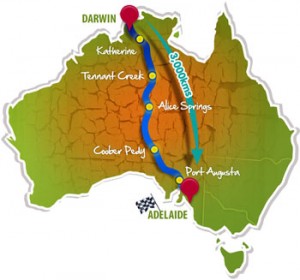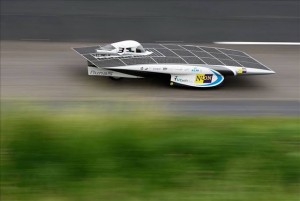 Panasonic Corporation of North America has announced their support for student teams in the Darwin-to-Adelaide, 3,021-kilometer 2011 World Solar Challenge in Australia this October. Panasonic is providing the latest Lithium Ion battery technologies for use with solar-powered vehicles engineered by undergraduate teams from the University of California at Berkeley and Stanford University in the seven day drive through the Australian Outback. Yesterday’s announcement came at Infineon Raceway’s first Accelerating Sustainable Performance Summit, a day-long forum for innovators and thought-leaders to explore prospects for sustainable automotive development and performance-oriented marketing of green cars. Peter Fannon, Vice President, Technology Policy, Panasonic Corporation of North America was on hand to wish the two teams the best of luck in proving their innovative solar car designs in the grueling Australian Outback environment.
Panasonic Corporation of North America has announced their support for student teams in the Darwin-to-Adelaide, 3,021-kilometer 2011 World Solar Challenge in Australia this October. Panasonic is providing the latest Lithium Ion battery technologies for use with solar-powered vehicles engineered by undergraduate teams from the University of California at Berkeley and Stanford University in the seven day drive through the Australian Outback. Yesterday’s announcement came at Infineon Raceway’s first Accelerating Sustainable Performance Summit, a day-long forum for innovators and thought-leaders to explore prospects for sustainable automotive development and performance-oriented marketing of green cars. Peter Fannon, Vice President, Technology Policy, Panasonic Corporation of North America was on hand to wish the two teams the best of luck in proving their innovative solar car designs in the grueling Australian Outback environment.
“These teams are truly proving the power of nature’s most ubiquitous fuel, the sun, and helping advance the time when sun power can be a routine part of transportation, and more in our daily lives,” said Mr. Fannon. “Panasonic is pleased to be part of realizing this vision.”In addition to the Lithium Ion batteries that will power the vehicles, Panasonic will also equip the two teams with ruggedized LUMIX digital cameras and Full HD camcorders to enable them to record their performance in the 1,877 mile vehicle endurance test. Although the cars competing in the World Solar Challenge are powered by solar energy, the sun’s rays are converted to electricity, which must be stored when not used immediately. This excess energy is stored in high-efficiency Lithium Ion batteries and is then used to power the vehicles when solar power is not feasible, for example, when it is cloudy or at night.
transportation, and more in our daily lives,” said Mr. Fannon. “Panasonic is pleased to be part of realizing this vision.”In addition to the Lithium Ion batteries that will power the vehicles, Panasonic will also equip the two teams with ruggedized LUMIX digital cameras and Full HD camcorders to enable them to record their performance in the 1,877 mile vehicle endurance test. Although the cars competing in the World Solar Challenge are powered by solar energy, the sun’s rays are converted to electricity, which must be stored when not used immediately. This excess energy is stored in high-efficiency Lithium Ion batteries and is then used to power the vehicles when solar power is not feasible, for example, when it is cloudy or at night.
A prestigious event that attracts the world’s best technical universities and colleges, the World Solar Challenge aims to help discover new automotive technologies that rely on the power of the sun by engaging student teams to develop electric vehicles for a week-long race across the Australian Outback. Currently in its 11th year, the 2011 event will host teams from all over the world to participate in the 3,021-kilometer journey. Dedicated to the goal of becoming the number one green business innovation leader in the electronics industry by 2018, Panasonic pledges to practice prudent, sustainable use of the earth’s natural resources and protect our environment through the company’s Eco Ideas programs.


